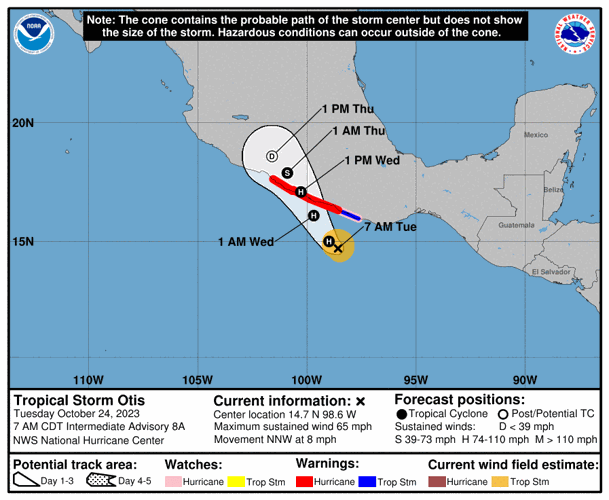Hurricane Tammy is moving away from the Gulf of Mexico after bringing minimal damage to Barbuda over the weekend as a Category 1 storm, according to the National Hurricane Center.
Located about 600 miles south-southeast of Bermuda, Tammy was producing sustained winds of 75 mph and moving northeast at 9 mph Tuesday morning, hurricane forecasters said. The storm brought heavy rain and high winds to parts of the Leeward Islands and other areas over the weekend, and swells generated by the storm should continue to impact the Leeward Islands, British and U.S. Virgin Islands and Puerto Rico throughout the next few days.

Though Tammy was on a westward track most of last week, Tuesday's forecast showed the storm heading northeast for most of this week, moving away from the Gulf of Mexico, before taking a sharp turn west toward Bermuda. The storm should hold steady at hurricane strength until late this week, when forecasters expect it to weaken some.
Hurricane forecaster first started tracking Tammy as a tropical wave off the coast of Africa and it formed as a tropical storm last week.
Tropical depression over Nicaragua
A tropical depression moving over Nicaragua is expected to bring heavy rains to the area and Honduras throughout much of the day Tuesday. The rain could cause flash and urban flooding and mudslides, forecasters said.
The depression is expected to dissipate quickly as it moves across land, according to the National Hurricane Center.
Tropical Storm Otis
Tropical Storm Otis is expected to become a hurricane in the Pacific Ocean as it heads for the southern coast of Mexico, where heavy rains and high winds are expected late Tuesday and Wednesday.

Storm surge is expect to produce significant coastal flooding and large waves in Mexico, forecasters said, and hurricane watches and warnings were issued throughout the region.
Tuesday's forecast showed Otis making landfall in Mexico as a hurricane and degenerating over land on Thursday.
The busiest time of hurricane season
We've officially entered what is historically the most active period of the Atlantic hurricane season, so consider this your reminder to get prepared and stay vigilant.

In the last 100 years, the tropics have been the most active in August, September and October, with Sept. 10 being the peak of the Atlantic hurricane season, according to federal forecasters. (graphic via NOAA)
In the last 100 years, the tropics have been busiest from mid-August through October, with Sept. 10 being the peak of the season, according to federal forecasters. About 80% of the systems that have hit the Gulf Coast formed during this time, according to the National Weather Service in Slidell.
The 2023 hurricane season
The return of El Niño was initially expected to bring a wetter second half of the year to Louisiana and a reduced risk of hurricanes.
The National Oceanic and Atmospheric Association's Climate Prediction Center announced March 9 that La Niña, which usually causes more hurricanes to form in the Atlantic, was officially over after an unusually long three years.
El Niño and its sister La Niña are part of the El Niño-Southern Oscillation cycle, a set of conditions over the Pacific Ocean that affects weather patterns across the world. In Louisiana, the biggest effects involve hurricane season in the Atlantic Ocean.
Regardless, this year's first cyclone hit in January, long before the official start of hurricane season, and June alone saw three named storms. Now forecasters are predicting that 2023 will prove to be an above-average hurricane season, with 18 named storms.
The first tropical storm to form in the Atlantic this year was named Arlene, reaching wind speeds of 40 mph on June 2 as it headed for Cuba. Don was the first storm to reach hurricane status in 2023, producing maximum sustained wind speeds of 75 mph on July 22 before rapidly weakening to a tropical storm the following day.
The next storm to form will be named Vince. Here's the full list of this year's storm names.
Don't miss a storm update this hurricane season. Sign up for our free Hurricane Center newsletter.





